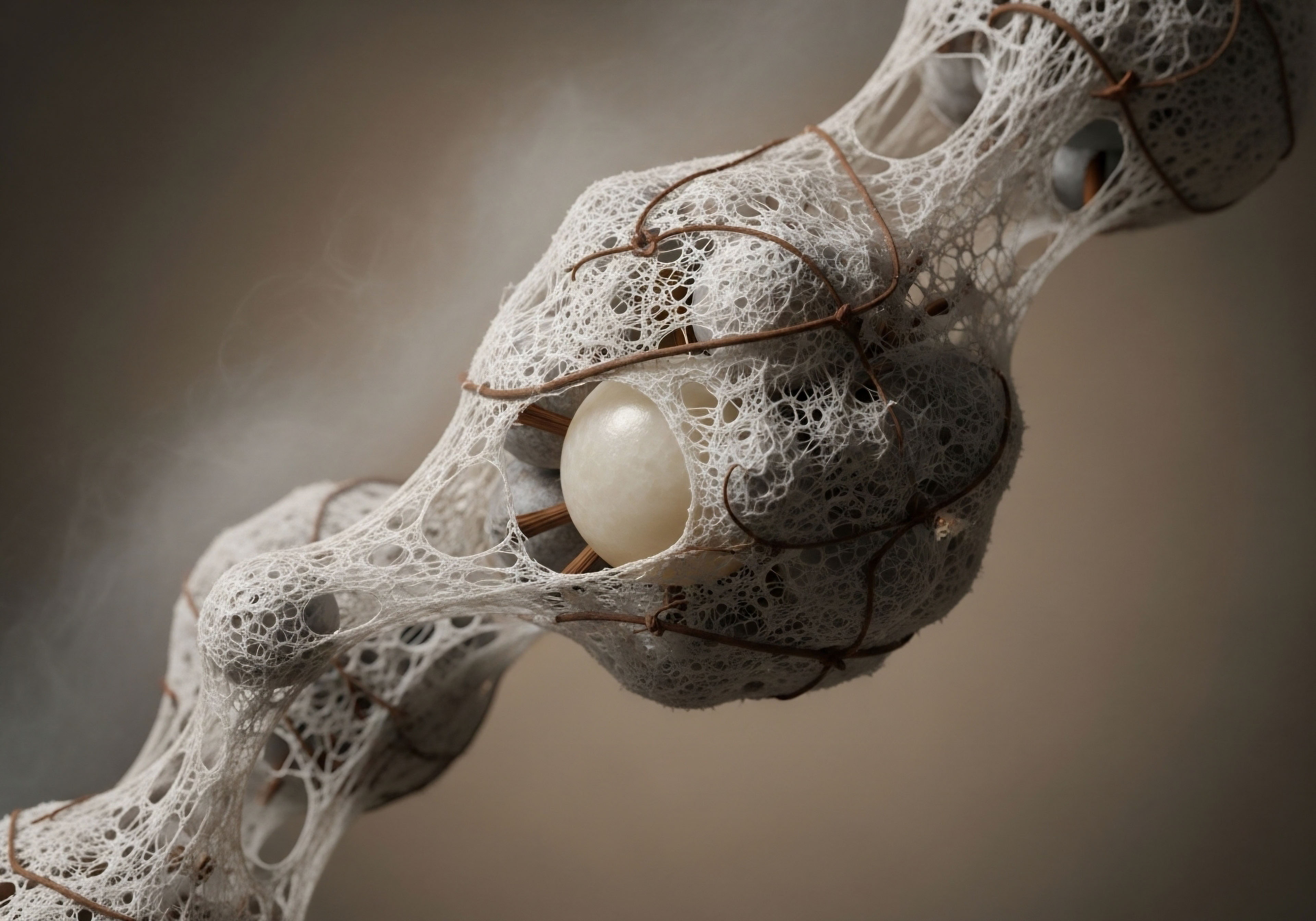

Fundamentals
Many individuals experience a subtle, yet persistent, decline in their overall vitality as the years progress. Perhaps you have noticed a gradual reduction in your energy levels, a diminished capacity for physical exertion, or a less robust sense of well-being.
These changes, often dismissed as simply “getting older,” can significantly impact daily life, making once effortless activities feel burdensome. You might find yourself questioning why your body no longer responds with the same vigor, or why your mental clarity seems less sharp. This lived experience of a shifting internal landscape is a powerful indicator that your biological systems, particularly your endocrine network, may be signaling a need for recalibration.
Understanding these internal signals is the first step toward reclaiming optimal function. The body operates as an intricate communication system, with hormones serving as essential messengers. These biochemical signals orchestrate nearly every physiological process, from your sleep patterns and mood stability to your metabolic rate and physical strength. When these messengers are out of balance, even slightly, the ripple effects can be felt across multiple systems, contributing to the very symptoms you might be experiencing.
Hormones act as the body’s internal communication network, influencing a vast array of physiological processes.

The Endocrine System an Overview
The endocrine system comprises a collection of glands that produce and secrete hormones directly into the bloodstream. These glands include the pituitary, thyroid, parathyroid, adrenal, and pineal glands, as well as the ovaries in women and testes in men. Each gland plays a distinct yet interconnected role in maintaining the body’s internal equilibrium.
For instance, the hypothalamic-pituitary-gonadal (HPG) axis represents a critical feedback loop regulating reproductive and metabolic health. The hypothalamus, located in the brain, sends signals to the pituitary gland, which then directs the gonads (testes or ovaries) to produce their respective hormones. This delicate interplay ensures appropriate hormone levels are maintained.
When this system functions optimally, you experience a state of hormonal balance, which supports robust health. However, various factors, including age, environmental influences, and lifestyle choices, can disrupt this delicate equilibrium. Recognizing these disruptions and their manifestations in your daily life is paramount to addressing them effectively.

What Are Hormonal Optimization Protocols?
Hormonal optimization protocols represent a strategic approach to restoring and maintaining optimal hormone levels within the body. This is not about simply replacing what is missing; it involves a precise, individualized strategy to bring the endocrine system back into a state of balance. These protocols are designed to address specific deficiencies or imbalances that contribute to a range of symptoms, aiming to improve overall well-being and physiological function.
For men, this often involves addressing symptoms associated with declining testosterone levels, a condition sometimes termed andropause. For women, protocols frequently address the complex hormonal shifts experienced during perimenopause and post-menopause, which can lead to irregular cycles, mood fluctuations, and diminished vitality. The objective is always to support the body’s inherent capacity for health, rather than merely masking symptoms.

How Do Peptides Interact with Hormonal Pathways?
Peptides are short chains of amino acids, the building blocks of proteins. They function as signaling molecules within the body, capable of influencing a wide array of biological processes. While hormones are typically larger, more complex molecules, peptides often act as precursors or modulators of hormonal activity. They can stimulate the release of specific hormones, regulate cellular communication, or influence metabolic pathways.
Consider the relationship between certain peptides and growth hormone. Some peptides, known as growth hormone-releasing peptides (GHRPs), directly stimulate the pituitary gland to produce and secrete more of the body’s own growth hormone. This is a different mechanism than directly administering synthetic growth hormone.
This approach aims to encourage the body’s natural physiological processes, supporting its intrinsic ability to produce essential compounds. The integration of peptides with existing hormonal optimization protocols therefore represents a sophisticated strategy, aiming to fine-tune the body’s internal regulatory mechanisms.


Intermediate
Moving beyond the foundational understanding of hormonal systems, we can now consider the specific clinical protocols employed to restore balance and vitality. These protocols are not one-size-fits-all solutions; instead, they are carefully tailored to individual physiological needs, guided by comprehensive diagnostic assessments. The precision involved in these interventions reflects a deep understanding of how the body’s internal communication systems operate and how they can be gently guided back to optimal function.

Testosterone Replacement Therapy for Men
For men experiencing symptoms of low testosterone, a condition often referred to as hypogonadism, Testosterone Replacement Therapy (TRT) can be a transformative intervention. Symptoms such as persistent fatigue, reduced libido, decreased muscle mass, and mood changes can significantly impact quality of life. The standard protocol frequently involves weekly intramuscular injections of Testosterone Cypionate, typically at a concentration of 200mg/ml. This method ensures a steady delivery of the hormone, helping to stabilize levels and alleviate symptoms.
To support the body’s natural endocrine function and mitigate potential side effects, TRT protocols often include additional agents. Gonadorelin, administered via subcutaneous injections twice weekly, helps maintain natural testosterone production and preserve fertility by stimulating the pituitary gland.
Another important component is Anastrozole, an oral tablet taken twice weekly, which helps manage the conversion of testosterone into estrogen, thereby reducing estrogen-related side effects. In some cases, Enclomiphene may be incorporated to further support the production of luteinizing hormone (LH) and follicle-stimulating hormone (FSH), which are critical for testicular function.
Tailored TRT protocols for men aim to restore testosterone levels while supporting natural endocrine processes and managing estrogen conversion.

Testosterone Replacement Therapy for Women
Women also experience the effects of declining hormone levels, particularly during the perimenopausal and post-menopausal phases. Symptoms can include irregular menstrual cycles, mood fluctuations, hot flashes, and a reduction in libido. For these individuals, specific testosterone optimization protocols are available. A common approach involves weekly subcutaneous injections of Testosterone Cypionate, typically at a lower dose of 10 ∞ 20 units (0.1 ∞ 0.2ml). This precise dosing helps to address symptoms without inducing masculinizing effects.
The protocol for women often includes Progesterone, prescribed based on individual menopausal status, to support hormonal balance and uterine health. Another option for long-acting testosterone delivery is pellet therapy, where small pellets are inserted subcutaneously, providing a sustained release of testosterone over several months. When appropriate, Anastrozole may also be used in women to manage estrogen levels, particularly in cases where testosterone conversion is a concern.

Post-TRT and Fertility Support for Men
For men who have discontinued TRT or are actively trying to conceive, a specialized protocol is employed to restore natural hormonal production and support fertility. This approach focuses on stimulating the body’s intrinsic mechanisms rather than external hormone administration. The protocol typically includes Gonadorelin, which encourages the pituitary to release LH and FSH, thereby signaling the testes to resume testosterone production.
Additionally, medications such as Tamoxifen and Clomid are often prescribed. These agents work by blocking estrogen receptors or stimulating gonadotropin release, respectively, further encouraging the body’s own hormone synthesis. In certain situations, Anastrozole may be included to manage estrogen levels during this period of hormonal recalibration, ensuring a more favorable environment for natural production.

Growth Hormone Peptide Therapy
Peptide therapy offers a distinct avenue for enhancing physiological function, particularly in the realm of growth hormone optimization. Unlike direct growth hormone administration, these peptides work by stimulating the body’s own pituitary gland to produce more growth hormone. This approach is favored by active adults and athletes seeking benefits such as improved body composition, enhanced recovery, and better sleep quality.
Several key peptides are utilized in this context:
- Sermorelin ∞ A growth hormone-releasing hormone (GHRH) analog that stimulates the pituitary to secrete growth hormone.
- Ipamorelin / CJC-1295 ∞ These are often combined. Ipamorelin is a selective growth hormone secretagogue, while CJC-1295 is a GHRH analog that provides a sustained release of growth hormone.
- Tesamorelin ∞ A GHRH analog specifically approved for reducing excess abdominal fat in certain conditions, also used for its broader metabolic benefits.
- Hexarelin ∞ Another potent growth hormone secretagogue, known for its ability to significantly increase growth hormone pulsatility.
- MK-677 ∞ An oral growth hormone secretagogue that stimulates growth hormone release by mimicking ghrelin.
These peptides are typically administered via subcutaneous injection, often at night, to align with the body’s natural pulsatile release of growth hormone.

Other Targeted Peptides and Their Applications
Beyond growth hormone modulation, other peptides offer specific therapeutic benefits:
PT-141, also known as Bremelanotide, is a peptide used to address sexual health concerns. It acts on melanocortin receptors in the brain, influencing sexual desire and arousal in both men and women. Its mechanism of action is distinct from traditional erectile dysfunction medications, as it targets central nervous system pathways involved in sexual response.
Pentadeca Arginate (PDA) is a peptide recognized for its role in tissue repair, healing processes, and inflammation modulation. It has been explored for its potential to support recovery from injuries and reduce inflammatory responses, thereby contributing to overall tissue health and functional restoration.
The integration of these targeted peptides with existing hormonal optimization protocols allows for a more comprehensive and individualized approach to wellness. By addressing specific physiological needs, these agents can complement the broader goals of hormonal balance, leading to more complete and sustained improvements in health.
| Protocol/Peptide Category | Primary Target Audience | Key Agents/Peptides | Mechanism of Action |
|---|---|---|---|
| TRT Men | Middle-aged to older men with low testosterone | Testosterone Cypionate, Gonadorelin, Anastrozole, Enclomiphene | Direct hormone replacement, pituitary stimulation, estrogen management |
| TRT Women | Pre/peri/post-menopausal women with hormonal symptoms | Testosterone Cypionate, Progesterone, Pellet Therapy, Anastrozole | Hormone supplementation, balance, sustained release, estrogen management |
| Post-TRT/Fertility Men | Men discontinuing TRT or seeking fertility | Gonadorelin, Tamoxifen, Clomid, Anastrozole | Stimulates natural hormone production, estrogen receptor modulation |
| Growth Hormone Peptides | Active adults, athletes seeking anti-aging, body composition | Sermorelin, Ipamorelin/CJC-1295, Tesamorelin, Hexarelin, MK-677 | Stimulates pituitary to release endogenous growth hormone |
| Sexual Health Peptides | Individuals with sexual dysfunction | PT-141 | Acts on brain receptors to influence sexual desire |
| Tissue Repair Peptides | Individuals seeking healing, inflammation reduction | Pentadeca Arginate (PDA) | Supports tissue regeneration and modulates inflammatory responses |


Academic
To truly appreciate the potential for integrating peptide therapy with existing hormonal optimization protocols, a deeper exploration into the underlying endocrinology and systems biology is essential. This level of understanding moves beyond symptomatic relief, focusing instead on the intricate feedback loops and molecular mechanisms that govern our physiological state. The body’s endocrine system is not a collection of isolated glands; it functions as a highly coordinated orchestra, where each component influences the others in a dynamic interplay.

The Hypothalamic-Pituitary-Gonadal Axis Recalibration
The Hypothalamic-Pituitary-Gonadal (HPG) axis stands as a central regulatory pathway for reproductive and metabolic health. The hypothalamus initiates the cascade by releasing gonadotropin-releasing hormone (GnRH), which then acts on the anterior pituitary gland. In response, the pituitary secretes luteinizing hormone (LH) and follicle-stimulating hormone (FSH).
These gonadotropins then travel to the gonads ∞ the testes in men and ovaries in women ∞ stimulating the production of sex steroids, primarily testosterone and estrogen. This intricate feedback mechanism ensures precise control over hormone synthesis.
When exogenous hormones are introduced, as in traditional Testosterone Replacement Therapy (TRT), the body’s natural production often diminishes due to negative feedback on the HPG axis. This suppression can lead to testicular atrophy in men or ovarian suppression in women. The integration of specific peptides, such as Gonadorelin, offers a sophisticated strategy to mitigate this suppression.
Gonadorelin, a synthetic analog of GnRH, directly stimulates the pituitary to release LH and FSH, thereby encouraging the gonads to maintain their endogenous hormone production. This approach helps preserve testicular size and function in men undergoing TRT, and can be critical for those considering future fertility.
Peptides like Gonadorelin can help preserve the body’s natural hormone production by stimulating the HPG axis.

Growth Hormone Secretagogues and Metabolic Pathways
The role of growth hormone extends far beyond simple growth, influencing a multitude of metabolic processes, body composition, and cellular repair. Endogenous growth hormone is released in pulsatile bursts, primarily during sleep, and its secretion is regulated by two key hypothalamic hormones ∞ growth hormone-releasing hormone (GHRH), which stimulates its release, and somatostatin, which inhibits it.
Peptides like Sermorelin and CJC-1295 are GHRH analogs, meaning they mimic the action of natural GHRH, prompting the pituitary to release more growth hormone. Ipamorelin and Hexarelin, on the other hand, are growth hormone secretagogues (GHS). They act on the ghrelin receptor in the pituitary, leading to a more robust and sustained release of growth hormone, often without significantly increasing cortisol or prolactin levels, which can be a concern with some other GHS.
The clinical implications of optimizing growth hormone levels via these peptides are substantial. Improved growth hormone status can lead to enhanced protein synthesis, increased lipolysis (fat breakdown), and improved glucose metabolism. This contributes to better body composition, with increased lean muscle mass and reduced adiposity.
Furthermore, growth hormone plays a role in collagen synthesis, supporting skin elasticity and joint health, and influences sleep architecture, promoting deeper, more restorative sleep cycles. The precise and physiological stimulation offered by these peptides represents a significant advantage over supraphysiological dosing of recombinant human growth hormone.

Neurotransmitter Modulation and Sexual Health
The interplay between hormones, peptides, and neurotransmitters is particularly evident in the realm of sexual health. Sexual function is a complex process involving hormonal, neurological, and psychological components. Traditional approaches to sexual dysfunction often focus on peripheral vascular mechanisms. However, peptides like PT-141 (Bremelanotide) offer a central nervous system-mediated approach.
PT-141 acts as a melanocortin receptor agonist, specifically targeting MC3R and MC4R receptors in the brain. These receptors are involved in regulating sexual arousal and desire. By activating these pathways, PT-141 can enhance central sexual motivation, leading to increased libido and improved sexual response in both men and women.
This mechanism is distinct from phosphodiesterase-5 (PDE5) inhibitors, which primarily affect blood flow. The ability of PT-141 to modulate central neurotransmitter systems provides a complementary strategy for addressing sexual health concerns, particularly those with a neurogenic component.

Tissue Repair and Inflammatory Pathways
The body’s capacity for repair and regeneration is a fundamental aspect of health and longevity. Chronic inflammation and impaired tissue healing can contribute to a range of degenerative conditions. Peptides are emerging as powerful tools in this domain due to their specific signaling properties.
Pentadeca Arginate (PDA), for instance, is a synthetic peptide derived from a naturally occurring growth factor. Its mechanism of action involves promoting cell proliferation, migration, and angiogenesis (new blood vessel formation), all critical processes for tissue repair.
Beyond direct tissue regeneration, PDA also exhibits anti-inflammatory properties. It can modulate the activity of various inflammatory mediators, helping to resolve chronic inflammatory states that impede healing. This dual action ∞ promoting repair and reducing inflammation ∞ makes PDA a compelling agent for supporting recovery from injuries, improving wound healing, and potentially mitigating chronic inflammatory conditions. The integration of such peptides into a comprehensive wellness protocol provides a targeted approach to enhancing the body’s intrinsic restorative capabilities.
| Peptide | Primary Mechanism | Clinical Application | Endocrine/Metabolic Interplay |
|---|---|---|---|
| Gonadorelin | GnRH analog, stimulates pituitary LH/FSH release | Preserving fertility/natural production during TRT | Directly influences HPG axis, prevents testicular atrophy |
| Sermorelin / CJC-1295 | GHRH analogs, stimulate pituitary GH release | Anti-aging, body composition, sleep quality | Increases endogenous GH, influences IGF-1, metabolic rate |
| Ipamorelin / Hexarelin | Ghrelin receptor agonists, stimulate pituitary GH release | Muscle gain, fat loss, recovery | Enhances GH pulsatility, affects appetite regulation |
| Tesamorelin | GHRH analog | Visceral fat reduction, metabolic health | Specific action on adiposity, improves lipid profiles |
| MK-677 | Oral ghrelin mimetic | GH release, appetite stimulation | Long-acting GH secretagogue, affects sleep and body composition |
| PT-141 | Melanocortin receptor agonist (MC3R/MC4R) | Sexual desire and arousal | Modulates central nervous system pathways for sexual function |
| Pentadeca Arginate (PDA) | Promotes cell proliferation, migration, angiogenesis; anti-inflammatory | Tissue repair, wound healing, inflammation reduction | Supports cellular regeneration, modulates immune response |
The precise application of these peptides, often in conjunction with traditional hormonal optimization protocols, represents a sophisticated approach to health. It acknowledges the complex, interconnected nature of biological systems, offering avenues to fine-tune physiological responses and support the body’s innate capacity for balance and vitality. This level of personalized intervention moves beyond simplistic treatments, aiming for a deeper, more enduring recalibration of internal function.

References
- Veldhuis, Johannes D. et al. “Gonadotropin-releasing hormone (GnRH) pulsatility ∞ an integral part of the neuroendocrine regulation of reproduction.” Journal of Neuroendocrinology, vol. 20, no. 6, 2008, pp. 675-689.
- Frohman, Lawrence A. and Michael O. Thorner. “Growth hormone-releasing hormone.” Journal of Clinical Endocrinology & Metabolism, vol. 86, no. 10, 2001, pp. 4607-4612.
- Corpas, Enrique, et al. “Growth hormone-releasing hormone (GHRH)-induced growth hormone (GH) secretion in healthy young and old men.” Journal of Clinical Endocrinology & Metabolism, vol. 75, no. 3, 1992, pp. 777-781.
- Pfaus, James G. et al. “The neurobiology of sexual desire.” Journal of Sexual Medicine, vol. 7, no. 1, 2010, pp. 101-113.
- Werb, Zena, and Michael J. Banda. “Elastase-alpha 1-proteinase inhibitor complexes in bronchoalveolar lavage fluid from patients with emphysema.” Journal of Clinical Investigation, vol. 70, no. 2, 1982, pp. 412-420.

Reflection
Your personal health journey is a dynamic process, shaped by countless internal and external factors. The insights gained from exploring hormonal health and peptide therapy are not merely academic; they serve as a guide for understanding your own unique biological blueprint.
Recognizing the subtle shifts in your body and seeking knowledge about its intricate systems represents a powerful act of self-advocacy. This understanding empowers you to engage in informed discussions about your well-being, moving toward a future where vitality and optimal function are not just aspirations, but lived realities. Consider this exploration a starting point, a catalyst for a deeper connection with your own physiology.



